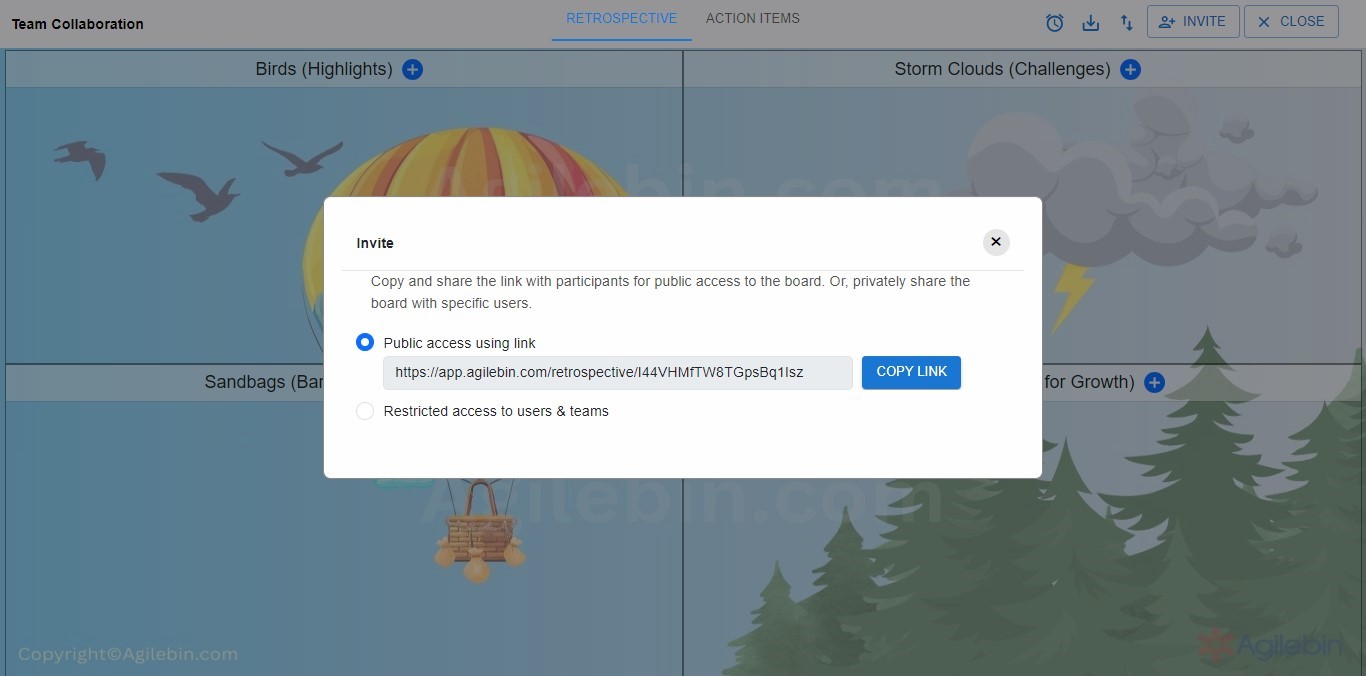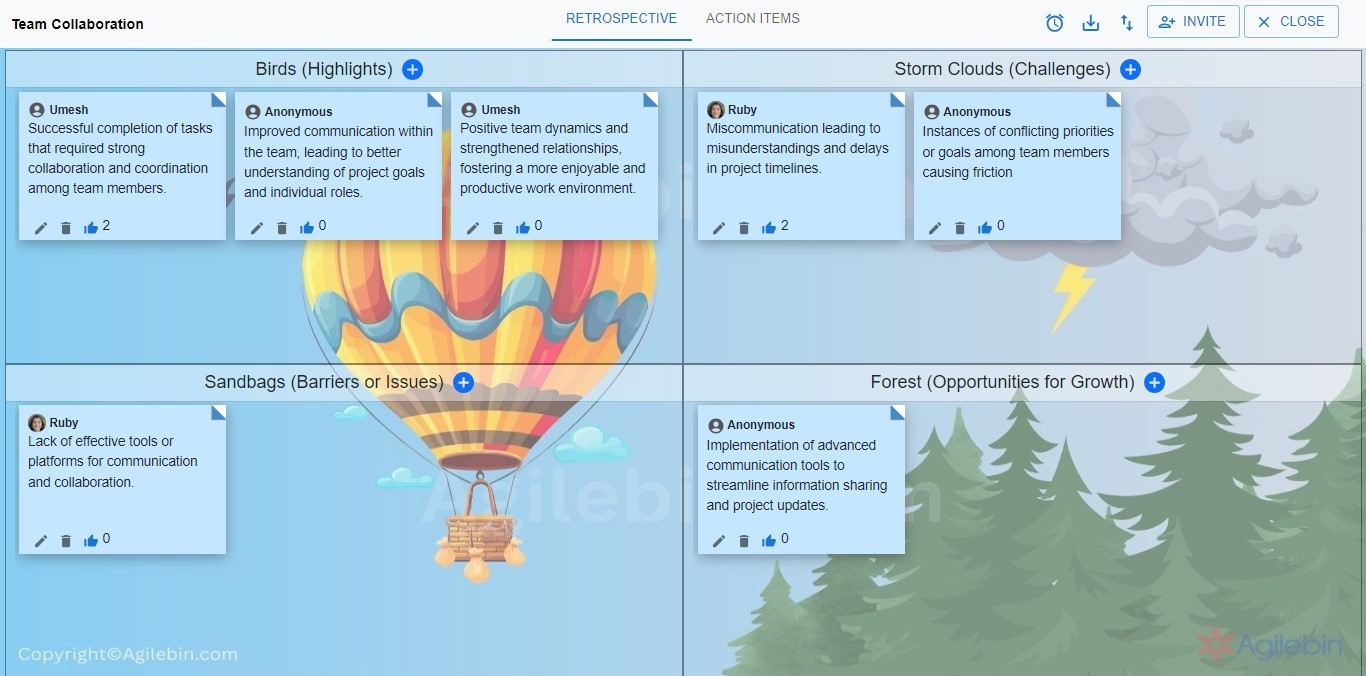Hot Air Balloon Retrospective
A Hot Air Balloon Retrospective is a team meeting to review successes, challenges, and improvements

What is Hot Air Balloon Retrospective?
A Hot Air Balloon Retrospective is a collaborative meeting held by agile teams at the end of a project iteration or sprint. It provides a structured opportunity for team members to reflect on their recent work, processes, and interactions, with the aim of improving team performance and effectiveness. This retrospective format derives its name from the metaphor of a hot air balloon ride, where participants rise above the landscape to gain a broader perspective.
During a Hot Air Balloon Retrospective, team members gather to discuss what went well during the iteration, what didn't go as planned, and what can be done to enhance future iterations. The retrospective encourages open and honest communication among team members, fostering a culture of continuous improvement and learning.
Typically, the retrospective follows a structured format, often guided by a facilitator. Team members may use various techniques such as brainstorming, affinity mapping, or timeline analysis to identify insights and action items. The outcome of the retrospective is a set of actionable items that the team commits to implementing in the next iteration, fostering a sense of ownership and accountability.
How to Run Hot Air Balloon Retrospective?
Running a Hot Air Balloon Retrospective involves several key steps to ensure its effectiveness and productivity:
- Prepare the Environment: Set up a conducive environment for the retrospective, ensuring that the space is comfortable, free from distractions, and conducive to open discussion.
- Set the Stage: Begin the retrospective by setting the stage and explaining the purpose and agenda. Emphasize the importance of constructive feedback and active participation from all team members.
- Gather Data: Collect relevant data and information about the iteration, including successes, challenges, issues, and opportunities for improvement. This may involve reviewing metrics, feedback from stakeholders, and observations from team members.
- Generate Insights: Facilitate a discussion among team members to identify insights and observations about what went well and what could be improved during the iteration. Encourage open and honest communication, allowing everyone to share their perspectives.
- Explore Perspectives: Use techniques such as affinity mapping, timeline analysis, or fishbone diagrams to explore different perspectives and uncover underlying causes of issues or successes. This helps the team gain a deeper understanding of the factors influencing their performance.
- Identify Action Items: Collaboratively identify actionable items or improvement opportunities based on the insights generated during the retrospective. Focus on specific actions that can be taken to address issues, capitalize on successes, or enhance team processes and dynamics.
- Assign Ownership: Assign ownership and accountability for each action item to ensure follow-through and implementation. Clearly define responsibilities, deadlines, and success criteria for each action item, fostering a sense of ownership and commitment among team members.
- Close the Retrospective: Conclude the retrospective by summarizing key insights, action items, and next steps. Ensure that everyone is aligned on the outcomes and commitments made during the retrospective. Thank the team for their participation and emphasize the importance of continuous improvement.
Columns in Hot Air Balloon Retrospective
- Birds (Highlights):This column is dedicated to capturing the positive aspects, achievements, or noteworthy events that occurred during the period being reviewed. It serves as a platform for celebrating successes, recognizing individual and team accomplishments, and acknowledging moments of excellence or progress.
- Storm Clouds (Challenges):In this column, the team identifies and discusses the various obstacles, difficulties, or hurdles encountered throughout the journey. It provides a space to reflect on challenges that may have impeded progress, affected morale, or posed significant difficulties for the team.
- Sandbags (Barriers or Issues):The Sandbags column focuses on identifying specific barriers, constraints, or issues that hindered the team's effectiveness or performance. It encompasses any factors, whether internal or external, that slowed down progress, created friction, or presented significant challenges to the team's objectives.
- Forest (Opportunities for Growth):Here, the team explores potential areas for improvement, development, or innovation. The Forest column encourages proactive thinking by highlighting opportunities to enhance processes, practices, or collaboration methods. It serves as a space for brainstorming creative solutions, experimenting with new ideas, and fostering continuous learning and growth within the team.
When to do a Hot Air Balloon Retrospective
The Hot Air Balloon Retrospective is best conducted at the end of a project milestone, sprint, or other significant period of work. It provides an opportunity for the team to reflect on recent activities, gather insights, and make adjustments for future iterations. Here are some key timings for conducting a Hot Air Balloon Retrospective:
- End of a Sprint: Agile teams often conduct retrospectives at the end of each sprint, typically lasting two to four weeks. This allows the team to reflect on their performance, adapt their processes, and improve collaboration before starting the next sprint.
- End of a Project Phase: When a project reaches a significant milestone or completes a phase of development, a retrospective can help the team review their progress, identify lessons learned, and make necessary adjustments before proceeding to the next phase.
- After a Major Event or Release: Following the completion of a major event, such as a product release, a conference, or a customer demonstration, a retrospective can provide valuable insights into what went well, what didn't, and how to improve for future events.
- Periodic Reviews: Teams may also schedule regular retrospectives at fixed intervals, such as monthly or quarterly, to continuously evaluate their performance, foster a culture of continuous improvement, and address any emerging issues proactively.
How can you conduct a Hot Air Balloon retrospective with Agilebin?
Effortlessly conduct a Hot Air Balloon retrospective with Agilebin's ready-to-use template!
Why Agilebin's template? Because it provides a realistic and immersive experience, making your Hot Air Balloon retrospective feel authentic and meaningful. With Agilebin's ready-to-use template, you'll feel like you're navigating through the actual process, allowing for a more effective and insightful retrospective session.
Choose Hot Air Balloon retrospective template in Agilebin
Choose the Hot Air Balloon Retrospective template from Agilebin's collection of retrospective templates. This template is specifically designed to facilitate the Hot Air Balloon Retrospective process, providing a structured framework for your team's reflection and improvement discussions
Invite team members to participate in the retrospective session
Invite team members to participate in the retrospective session by adding their email addresses or sharing the session link directly with them. You can choose between public access using a link, allowing anyone with the link to join, or restricted access, limiting participation to specific users or teams.

Facilitate Discussion with Sticky Notes
Agilebin offers pre-defined columns for the Hot Air Balloon Retrospective, including "Birds (Highlights)," "Storm Clouds (Challenges)," "Sandbags (Barriers or Issues)," and "Forest (Opportunities for Growth)." Participants can add sticky notes to each column during the retrospective session, sharing their feedback, observations, and suggestions
